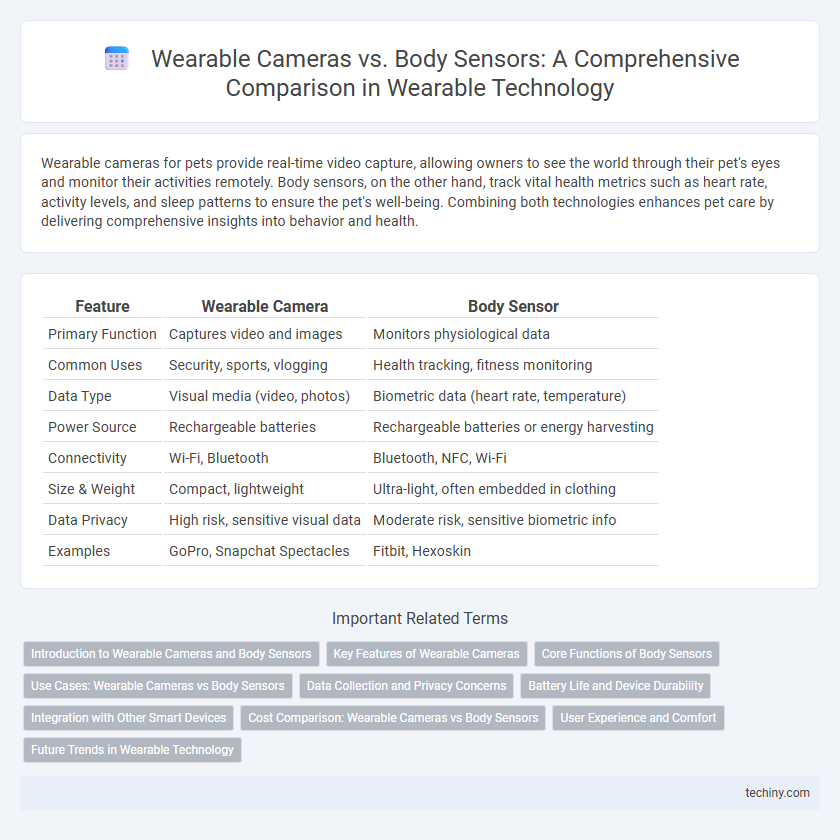Wearable cameras for pets provide real-time video capture, allowing owners to see the world through their pet's eyes and monitor their activities remotely. Body sensors, on the other hand, track vital health metrics such as heart rate, activity levels, and sleep patterns to ensure the pet's well-being. Combining both technologies enhances pet care by delivering comprehensive insights into behavior and health.
Table of Comparison
| Feature | Wearable Camera | Body Sensor |
|---|---|---|
| Primary Function | Captures video and images | Monitors physiological data |
| Common Uses | Security, sports, vlogging | Health tracking, fitness monitoring |
| Data Type | Visual media (video, photos) | Biometric data (heart rate, temperature) |
| Power Source | Rechargeable batteries | Rechargeable batteries or energy harvesting |
| Connectivity | Wi-Fi, Bluetooth | Bluetooth, NFC, Wi-Fi |
| Size & Weight | Compact, lightweight | Ultra-light, often embedded in clothing |
| Data Privacy | High risk, sensitive visual data | Moderate risk, sensitive biometric info |
| Examples | GoPro, Snapchat Spectacles | Fitbit, Hexoskin |
Introduction to Wearable Cameras and Body Sensors
Wearable cameras capture real-time video and images, enabling hands-free recording for activities such as sports, security, and healthcare monitoring. Body sensors track physiological and biomechanical data like heart rate, movement, and temperature to provide insights into physical health and performance. Both devices enhance personal data collection by integrating advanced sensors with wearable technology for seamless, continuous monitoring.
Key Features of Wearable Cameras
Wearable cameras feature high-resolution video capture, hands-free operation, and real-time connectivity for live streaming or instant sharing. These devices often include built-in storage, GPS tracking, and advanced stabilization technology to ensure clear footage during physical activities. Unlike body sensors, wearable cameras primarily focus on visual documentation, making them ideal for security, sports, and field research applications.
Core Functions of Body Sensors
Body sensors in wearable technology primarily monitor vital signs such as heart rate, body temperature, and blood oxygen levels, enabling real-time health assessment and early detection of medical conditions. Unlike wearable cameras that focus on capturing visual data, body sensors provide continuous physiological data essential for fitness tracking, chronic disease management, and personalized healthcare. These sensors often integrate with mobile applications and cloud platforms to offer comprehensive analytics and actionable insights for users and healthcare professionals.
Use Cases: Wearable Cameras vs Body Sensors
Wearable cameras excel in capturing real-time visual data for applications like law enforcement, sports analysis, and security monitoring, providing first-person perspectives and evidence collection. Body sensors specialize in tracking physiological metrics such as heart rate, movement, and posture, supporting fitness training, health monitoring, and rehabilitation. Both devices complement each other, with cameras focusing on environmental capture and sensors delivering biometric insights for comprehensive wearable technology solutions.
Data Collection and Privacy Concerns
Wearable cameras capture continuous visual data, offering detailed contextual information but raising significant privacy concerns due to the potential recording of bystanders without consent. Body sensors primarily gather physiological and movement data, which, while less intrusive visually, pose risks related to sensitive health information and unauthorized data access. Both technologies demand robust data protection measures to balance effective data collection with user and bystander privacy rights.
Battery Life and Device Durability
Wearable cameras typically offer battery life ranging from 4 to 8 hours, optimized for continuous video recording, while body sensors generally extend beyond 24 hours due to lower power consumption focused on data tracking. Durability standards for wearable cameras often include IP67 or higher, ensuring resistance to water and dust, whereas body sensors emphasize shock resistance and flexibility to withstand rigorous physical activity. Battery efficiency and structural robustness remain critical for both devices, influencing user experience in health monitoring and security applications.
Integration with Other Smart Devices
Wearable cameras offer seamless integration with smartphones and cloud platforms, enabling real-time video streaming and instant data sharing for enhanced surveillance and activity tracking. Body sensors connect effortlessly with health monitoring systems and smart home devices, providing continuous biometric data that supports personalized healthcare and automation. Both technologies leverage Bluetooth and Wi-Fi protocols to maintain synchronized communication, optimizing user experience across multisensor ecosystems.
Cost Comparison: Wearable Cameras vs Body Sensors
Wearable cameras generally have higher upfront costs, ranging from $200 to $600, due to advanced video recording and storage capabilities, while body sensors typically cost between $50 and $300, focusing on biometric data collection such as heart rate and motion detection. Maintenance and data management expenses are often greater for wearable cameras because of large video file storage and processing needs, whereas body sensors incur lower ongoing costs linked to sensor calibration and data analysis software subscriptions. Choosing between wearable cameras and body sensors depends on budget constraints and intended application, with cameras favoring visual documentation and sensors supporting health and fitness monitoring.
User Experience and Comfort
Wearable cameras prioritize high-resolution video capture with ergonomic designs to minimize wearer discomfort during extended use, while body sensors focus on lightweight, unobtrusive monitoring of physiological data to enhance real-time health and activity tracking. User experience with wearable cameras often emphasizes seamless integration with mobile apps for easy media access, whereas body sensors excel in providing continuous biofeedback without restricting movement. Comfort is optimized in wearable cameras through adjustable straps and padding, whereas body sensors utilize flexible materials and adhesive patches to maintain skin contact without irritation.
Future Trends in Wearable Technology
Wearable cameras are evolving with enhanced image processing and AI-driven analytics, enabling real-time surveillance and health monitoring. Body sensors are advancing in biometric data accuracy and integration with IoT devices, facilitating continuous health diagnostics and personalized fitness tracking. Future trends in wearable technology emphasize seamless connectivity, miniaturization, and energy-efficient materials to improve user comfort and data reliability.
Wearable Camera vs Body Sensor Infographic

 techiny.com
techiny.com